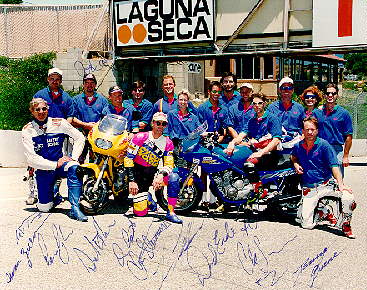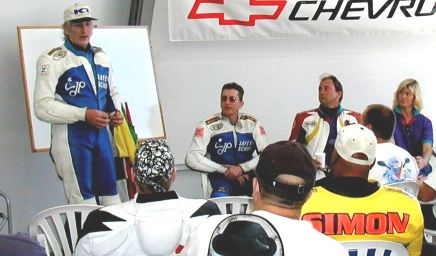
Recently, through a mutual friend, I met former AMA Battle of the Twins champ Chris Steward, owner of Trail Boss Tours and instructor at DP Safety School. Chris and I spent a day at Willow Springs, an experience I wrote about on January 2, 2000.
Chris suggested that I get ahold of Dennis Pegelow, owner of DP Safety School, and attend one of his schools. DP is one of the most respected riding schools in the U.S. conducting 17 schools at seven different roadrace tracks in the Western United States during the year 2000.
 DP School’s Staff (Click for List) DP School’s Staff (Click for List) |
DP is the fulfillment of the dream of its founder and owner, Dennis Pegelow, who vowed he would start a motorcycle riding school after recovering from cancer several years ago. Dennis is the lead instructor, and he has assembled an extremely impressive staff of experienced roadracers and street riders. This is a picture of his staff and a listing of some of their credentials.
On March 3, 2000, I traveled to the new Pahrump, Nevada track with my buddy Jeff Whitmer from Temecula Motorsports. Temecula Motorsports was nice enough to loan us a long bed pick up truck, and loan me a 2000 Kawasaki ZX-6R. With the Kawasaki and Jeff’s Yamaha R1 stuffing the bed of the truck, we were off for Nevada from Temecula, California.
Pahrump is a relatively small town northwest of Las Vegas where, virtually in the middle of the desert, a new roadrace course has been built. The Pahrump track consists of 16 turns. The track is tricky for a newcomer, and requires several laps of familiarization.
Before I talk more about the Pahrump track, I’m going to tell you about my experience with DP.
After a brief technical inspection of your bike (taping your lights is required, safety wiring is not), a classroom session is held.
The group of riders (numbering 21, in our instance) was divided into three classes, “A”, “B” and “C”. The “A” riders were the most experienced and the fastest, the “B” riders had some prior track experience, and the “C” riders were either beginners or street riders without previous track experience.
Although I have prior track experience, I spent the first half of the day with the “C” group to get the full flavor of the DP teaching method. The “A” and “B” groups, after the initial orientation (discussing flags, general track safety, and some DP philosophy) were led separately onto the track by an experienced instructor. Former AMA and Daytona 200 Champion Dave Emde led the “A” Group, while Chris Steward led the “B” Group. Emde and Steward were somewhat familiar with the track (having only ridden it for a short while themselves, but at least they had ridden it), so they led their groups in a “follow-the-leader” procession for a few laps, showing the correct lines around the track, and trying to familiarize their groups with the turns.
The initial orientation (involving all three groups) was in the classroom setting with Dennis Pegelow speaking. Dennis is a very experienced racer and rider himself, sharing anecdotes along the way about his own racing experiences (including a story about trying to follow Kenny Roberts on the track in the 1970’s). Dennis has a relaxed and practical approach to teaching riding safety and track technique. He emphasizes relaxation, and encourages each rider to stay within his or her limits on the track without feeling the need to compete with other students.

The “C” group receives special attention from Dennis and other instructors. The “C” group was also led through a “follow-the-leader” session on the track, allowing the “C” riders to have an initial experience of the track at a low speed behind an experienced roadracer who was following the correct lines — lines that should be followed at any speed on the track. After some follow-the-leader, the “C” group instructor would allow individual students to take the lead for a lap, and follow and observe those students in order to critique them later.
After each session, the “C” students returned to the classroom. They were encouraged to ask questions about the track, cornering technique, braking technique, and anything else that came to mind. The relaxed setting and Dennis’ approach to teaching, seemed to draw out questions from even shy students. Dennis did his best to make the most inexperienced riders comfortable and confident.
Further track sessions with the “C” group involved more individualized instruction and critique of student riding techniques by the experienced roadracers on Dennis’ staff. After spending the morning with the “C” group, I moved up to ride with the “A” and “B” group (which had been combined, due to the small number of “A” and “B” riders). In this group, I had the opportunity to work one-on-one with a DP instructor. Several instructors were present at Pahrump, despite the small number of students travelling to Nevada for this school. I chose to ride with Chris Steward, who followed me for a few laps around the track, and then I followed him to watch his lines. The pace had quickened quite a bit, and I felt that I was making significant progress with my cornering techniques and speed.
During the afternoon, the “C” group continued to have class sessions after each track session, and spent some time working on aggressive braking techniques (emphasizing use of the rear brake — something a surprising number of street riders completely ignore). Dennis explained the importance of the rear brake in settling and balancing the bike, but also pointed out that the vast majority of the braking force is applied by the front brake due to weight shift under braking. I watched as the staff carefully observed the braking technique of the “C” group riders and gave them pointers for improvement not only on the track but, more importantly, on the street.
The “C” group riders were also told extensively about different cornering techniques, and important lines to take while cornering on the race track (being careful to point out that those same lines are inappropriate in most street situations). Street safety was also discussed and stressed.
The “A” and “B” group riders are free most of the day to work on their track technique, either alone or under the close scrutiny of one of Dennis’ experienced instructors. With only 21 riders at the Pahrump track, there was plenty of room for everyone to ride at their own pace.
DP provides complimentary coffee, fruit and donuts in the morning, and a healthy lunch at noon. Cold water and Gatorade dispensers kept students hydrated.
DP is also an excellent school for skilled track riders or racers. The ability to work one-on-one with former national champions, along with the large amount of track time available at DP’s schools (up to five hours on the track if you purchase the “E-ticket ride”) is invaluable. Experienced riders can use DP as a largely unsupervised track day, or take advantage of input on their riding technique from one or more experienced racers/instructors.
DP’s program fees are reasonable, and range from $250 to $325 for the basic program (depending on the track and the time of year). The “E-ticket ride” is a special program offered by DP to experienced riders who are afforded the opportunity to spend the entire day with the instructor of their choice — riding with both the “A” and “B” groups (up to five hours on the track). The price of the “E-ticket ride” is $800.
DP visits several tracks in the Western United States, including Buttonwillow, Laguna Seca, Sears Point and Thunderhill in California; Pahrump in Nevada; Portland, Oregon; and Seattle, Washington.
If you are looking for a fun day at the race track, and would like to receive some quality instruction at the same time for a reasonable price, you can’t go wrong with DP Safety School. Don’t be intimidated by the all-star cast of instructors. These former racers are down-to-earth and very capable of working with riders of all skill levels. Refer to DP’s website for details on this years’ classes.
Note on the Pahrump track:
The Pahrump track is a blast to ride. There is really only one bump on the entire track, and traction is very consistent and plentiful. There are several interesting corners, some of which are modeled exactly from famous corners on other race tracks around the world. Interesting and challenging cornering techniques are involved at several of the corners, including at least two double apexes, one of which is extremely difficult to negotiate in one smooth arc (something I did only once all day).





